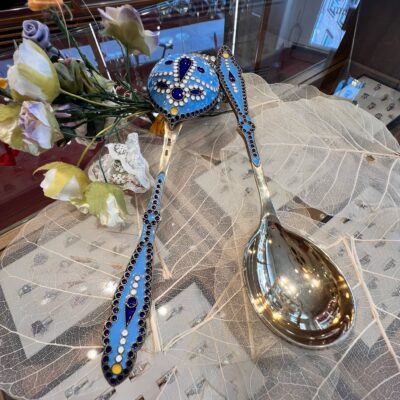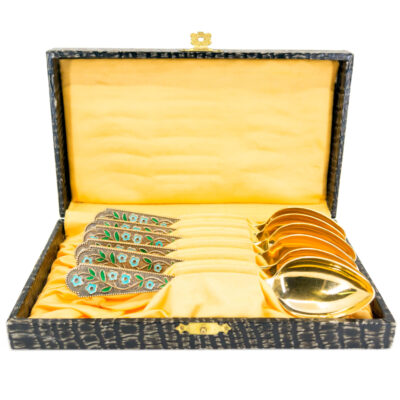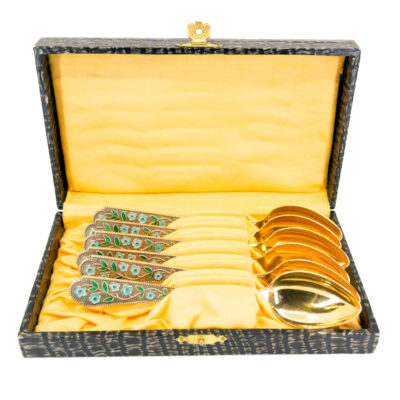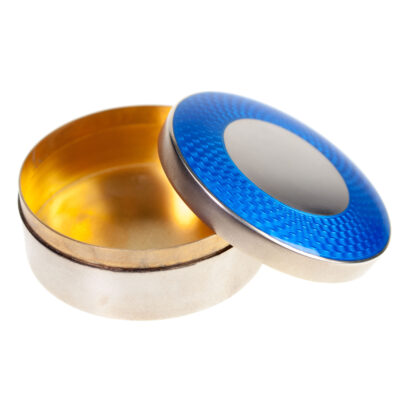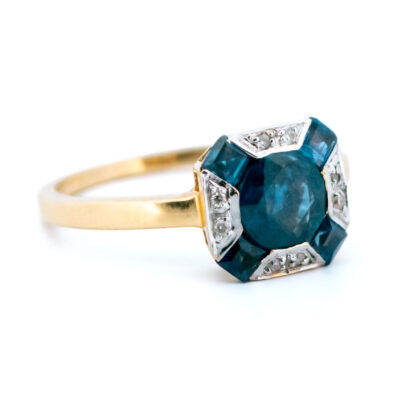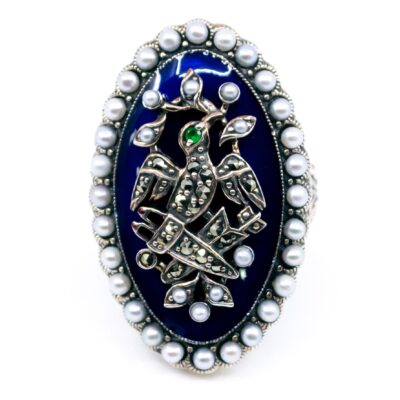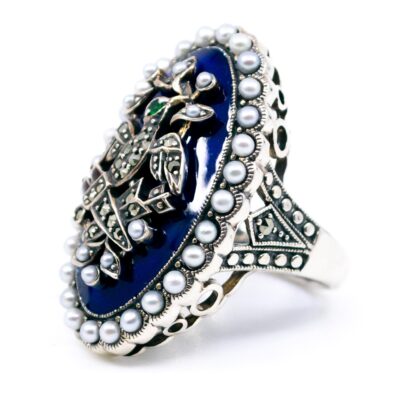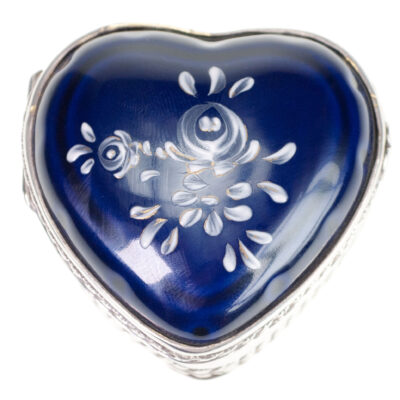Revel in the exquisite craftsmanship of our 1934 Barker Brothers Birmingham spoon set, delicately handcrafted from lustrous 925 SILVER-GILT. Enamel accents bring a delightful contrast, while the classic Deco aesthetic imparts a sense of timeless elegance. Enjoy the luxury of history, wrapped in a chic style.
Videos
Details: Enamel, Silver-gilt Spoon Set.
Dimensions: 10.5 x 2 cm.
Weight in grams: 69.
Condition: Good condition – used with some signs of wear.
Shipping and Pickup: This classic piece ships from our store located in the center of Amsterdam, The Netherlands. We offer both registered shipping and local pickup at our store. In the case of local pickup, any applicable shipping costs will be refunded.
About Us: Add some sparkle to your style with Binenbaum.com. We offer a stunning selection of antique and vintage jewelry that you won’t find anywhere else. From timeless rings and dazzling necklaces to unique brooches, we have something for every taste and occasion. Visit our website today and treat yourself to a piece of history.
| Design Era | |
|---|---|
| Design & Historical Context | Art Deco jewelry, also known as Jazz Age jewelry, became popular in the 1920s and remained in style through the 1930s. It was named after the Exposition International des Arts Décoratifs et Industriels Modernes, a exhibition held in Paris in 1925 that was largely dedicated to the jewelry arts. This style was inspired by a variety of cultural and artistic movements, such as Oriental, African, and South American art, as well as Cubism and Fauvism. Art Deco jewelry is known for its sharp, straight lines and emphasis on modernity and the machine age. During the Art Deco era, there were significant improvements in diamond cutting techniques, which made diamonds more radiant and sparkling than ever before. This, along with increased prosperity, allowed more people to afford diamond jewelry and engagement rings. Additionally, new casting techniques made it possible to produce more intricate and detailed settings. Art Deco jewelry was not only fashionable but also reflected the social and cultural changes of the time. The bold, modern design of Art Deco jewelry reflected the liberation and empowerment of women during the 1920s and 1930s. Today, Art Deco jewelry is highly sought after by collectors and is often featured in museum exhibitions and high-end auctions. |
| Key Materials | |
| Materials & Craftsmanship | Silver-gilt: The Fusion of Luxury and Affordability Silver-gilt, also known as vermeil or gilded silver, is a luxurious yet accessible material that combines the beauty of gold with the affordability of silver. This technique involves coating a base of sterling silver with a thin layer of gold, typically 10k or higher, creating a piece that has the rich, warm appearance of gold while maintaining the strength and durability of silver. Historically, silver-gilt has been used for centuries in the creation of fine jewelry, religious artifacts, and decorative objects. The process of gilding, or applying a gold layer to silver, dates back to ancient times and was especially popular in the Middle Ages and Renaissance periods, where it was used to create elaborate and ornate pieces for royalty and the church. The technique allowed artisans to produce items with the appearance of solid gold at a fraction of the cost. In modern jewelry, silver-gilt is prized for its versatility and elegance. The gold layer provides a luxurious finish that is resistant to tarnish, while the silver base offers durability and a more affordable price point compared to solid gold. Silver-gilt jewelry can range from delicate, minimalist designs to bold, statement pieces, making it suitable for a wide range of styles and occasions. Silver-gilt is often used in rings, necklaces, bracelets, and earrings, where the combination of gold's warmth and silver's strength creates pieces that are both beautiful and long-lasting. The thickness of the gold layer can vary, with vermeil being a specific type of silver-gilt where the gold layer is at least 2.5 microns thick and typically made from higher karat gold. Silver-gilt is more than just a material; it is a blend of luxury and practicality, offering the appearance of gold without the full expense. Its historical significance and enduring appeal make it a popular choice for those who appreciate the beauty of gold and the durability of silver. Whether in classic designs or contemporary pieces, silver-gilt jewelry adds a touch of elegance and sophistication to any collection. Enamel: The Artful Fusion of Color and Craftsmanship Enamel is a decorative technique that has been used in jewelry for centuries, known for its ability to bring vibrant color and intricate designs to metal surfaces. Created by fusing powdered glass to metal at high temperatures, enamel can produce a wide range of colors, from bold and opaque to translucent and delicate. Historically, enamel has been used across various cultures, from ancient Egypt and China to Renaissance Europe, to create stunning works of art in jewelry, religious artifacts, and decorative objects. The intricate process of enameling, which requires skill and precision, has made it a prized technique among artisans. In contemporary jewelry, enamel is appreciated for its versatility and ability to enhance the beauty of metalwork. It can be used to add a pop of color to a piece, create detailed imagery, or produce a smooth, glossy finish that complements gemstones and precious metals. Enamel not only adds a burst of color and creativity to jewelry but also represents the craftsmanship and artistry behind each piece. Whether in modern or vintage designs, enamel brings a unique and timeless appeal to jewelry, making it a cherished choice for those who appreciate fine detail and vibrant hues. |
| Dimensions | 10.5 x 2 cm |
| Gender | |
| Weight (in grams) | 69 |
| Condition |
By following these tips, you can enjoy your precious jewelry for many years to come.
Related Products
-
Enamel Silver-Gilt Cloissoné Spoon Set 11794-2854
€ 895,00 VAT incl. (where applicable) -
Enamel Silver Cloissoné Spoon Set 11790-2853
€ 895,00 VAT incl. (where applicable) -
Enamel Silver Silver-Gilt Guilloche Box 1427-1904
€ 795,00 VAT incl. (where applicable) -
Enamel Marcasite (Pyrite) Pearl 925′ Silver Pendant 17696-3157
€ 295,00 VAT incl. (where applicable) -
Enamel Marcasite (Pyrite) Topaz 925′ Silver Ring 17654-3122
€ 285,00 VAT incl. (where applicable) -
Diamond Sapphire 14k Deco Ring 14393-8321
€ 1.795,00 VAT incl. (where applicable) -
Emerald Enamel Marcasite (Pyrite) Pearl Silver Figural Ring 14182-1517
€ 375,00 VAT incl. (where applicable) -
Enamel Porcelain Silver Heart-Shape Box 827-0841
€ 595,00 VAT incl. (where applicable)
- Home
- Collection
- Fine Jewelry
- Silver Jewelry
- Silverware
- Boxes
- Candlesticks
- Salt and pepper shakers
- Miniatures
- Salt cellars
- Spoon Set
- Condiments
- Frames
- Napkin Ring
- Spoon
- Oddities
- Cups
- Vases
- Cutlery
- Serving Spoon And Cake Server
- Candlesticks
- Baskets
- Hanukkiah
- Spice Tower
- Yad
- Tea Set
- Sugar Castor
- Napkin Rings
- Wine Bottle Coaster
- Wine Stopper
- Tea Pot
- Jugs
- Rattles
- Hip Flask
- Miscellaneous
- Rings 💍
- About
- Contact





